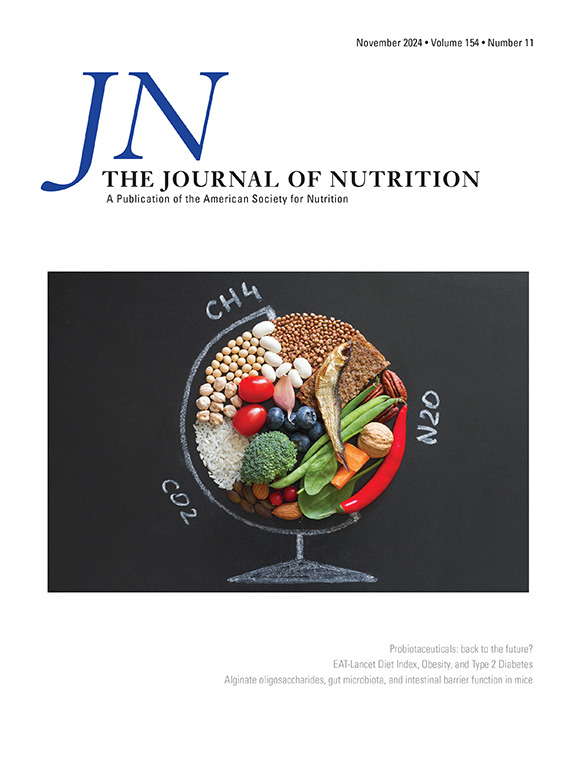Folic Acid-Containing Supplement Use among Females Aged 15–55 in the Canadian Community Health Survey 2015–2018
IF 3.7
3区 医学
Q2 NUTRITION & DIETETICS
引用次数: 0
Abstract
Background
In Canada, those who are or who could become pregnant are recommended to consume a daily multivitamin containing 400 μg of folic acid to help prevent neural tube defects.
Objectives
This study aims to report the prevalence and determinants of folic acid-containing supplement use among females of childbearing age in Canada.
Methods
Data were combined from cycles 2015/2016 and 2017/2018 of the maternal experiences module of the cross-sectional Canadian Community Health Survey, which was completed by females aged 15–55 y. Representative weighted estimates (means/percentages, 95% confidence interval) were generated for folic acid-containing supplement use among all pregnant, nonpregnant, and lactating respondents. For those who had given birth in the preceding 5 y, estimates were also generated for supplement use in the 3 mo before and first 3 mo of their most recent pregnancy, and prepregnancy awareness of the link between folic acid and some birth defects. We examined associations with sociodemographic factors using multivariable logistic regression.
Results
Overall, 16.5% (15.9%, 17.0%) of nonpregnant, 80.3% (77.1%, 83.5%) of pregnant, and 58.4% (54.8%, 61.9%) of lactating females aged 15–55 reported using a folic acid-containing supplement. Among those who had given birth in the preceding 5 y, 63.7% (62.2%, 65.1%) consumed a folic acid-containing supplement in the 3 mo before pregnancy, whereas 89.9% (88.8%, 90.9%) did so during the first trimester. A lower prevalence of supplement use before or during pregnancy was reported among the 23.7% (22.4%, 25.1%) of respondents unaware of the relationship between folic acid and birth defects. Younger age, single marital status, lower educational attainment, income below the median, and smoking were associated with lower odds of awareness or supplement use.
Conclusions
Although most females living in Canada reported using folic acid-containing supplements prior to and during pregnancy, use of these supplements among nonpregnant females of childbearing age is low, and sociodemographic inequalities exist.
2015-2018年加拿大社区健康调查中15-55岁女性含叶酸补充剂的使用情况
简介:在加拿大,建议怀孕或可能怀孕的妇女每天服用含有400 μg叶酸的复合维生素,以帮助预防神经管缺陷。目的:报告加拿大育龄女性使用含叶酸补充剂的患病率和决定因素。方法:结合2015/16周期和2017/18周期加拿大横断面社区卫生调查产妇经历模块的数据,这些数据由15-55岁的女性完成。对所有怀孕、非怀孕和哺乳期受访者中含叶酸补充剂的使用情况进行了代表性加权估计(平均值/百分比,95% CI)。对于那些在前5年内分娩的妇女,我们还估算了她们在怀孕前3个月和最近一次怀孕的前3个月补充剂的使用情况,以及孕前对叶酸和一些出生缺陷之间联系的认识。我们使用多变量逻辑回归检查了与社会人口因素的关联。结果:总体而言,16.5%(15.9-17.0%)的未怀孕女性,80.3%(77.1-83.5%)的怀孕女性和58.4%(54.8-61.9%)的15-55岁哺乳期女性报告使用含叶酸补充剂。在过去5年内分娩的妇女中,63.7%(62.2% -65.1%)在怀孕前3个月内服用了含叶酸的补充剂,89.9%(88.8-90.9%)在怀孕前三个月服用了叶酸补充剂。23.7%(22.4-25.1%)的受访者不知道叶酸与出生缺陷之间的关系,在怀孕前或怀孕期间服用补充剂的患病率较低。年龄较小、婚姻状况单一、受教育程度较低、收入低于中位数以及吸烟与认知或服用补充剂的几率较低有关。结论:虽然大多数居住在加拿大的女性报告在怀孕前和怀孕期间使用含叶酸补充剂,但这些补充剂在未怀孕的育龄女性中的使用率很低,并且存在社会人口不平等。临床试验注册号:不适用meta分析系统评价的注册号和注册号:不适用。
本文章由计算机程序翻译,如有差异,请以英文原文为准。
求助全文
约1分钟内获得全文
求助全文
来源期刊

Journal of Nutrition
医学-营养学
CiteScore
7.60
自引率
4.80%
发文量
260
审稿时长
39 days
期刊介绍:
The Journal of Nutrition (JN/J Nutr) publishes peer-reviewed original research papers covering all aspects of experimental nutrition in humans and other animal species; special articles such as reviews and biographies of prominent nutrition scientists; and issues, opinions, and commentaries on controversial issues in nutrition. Supplements are frequently published to provide extended discussion of topics of special interest.
 求助内容:
求助内容: 应助结果提醒方式:
应助结果提醒方式:


